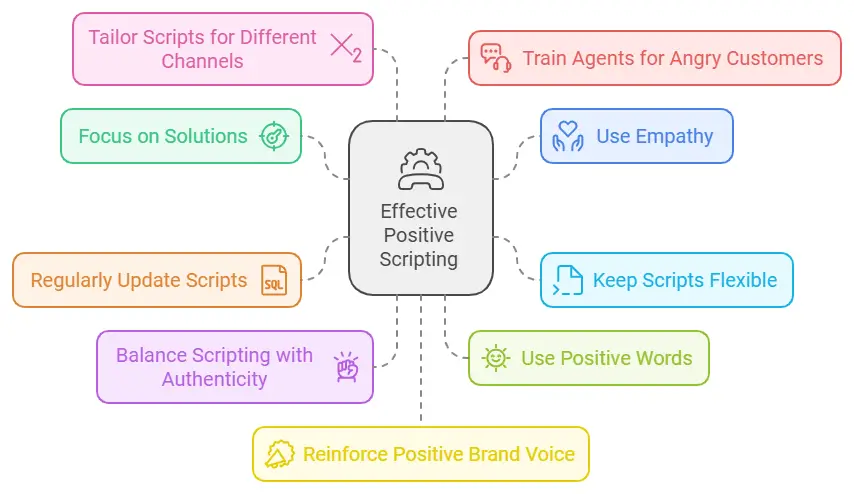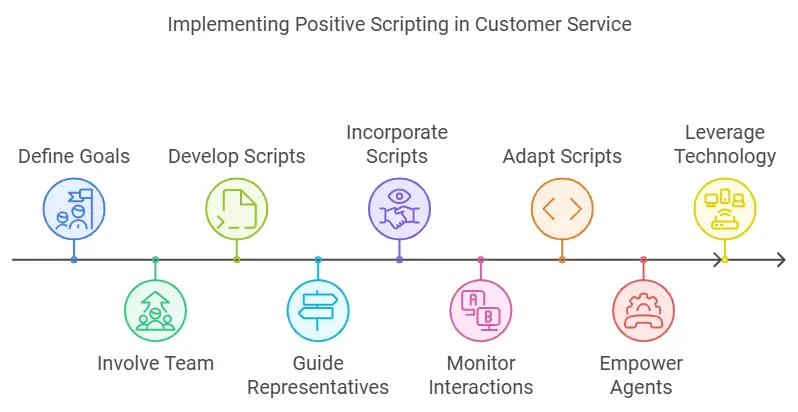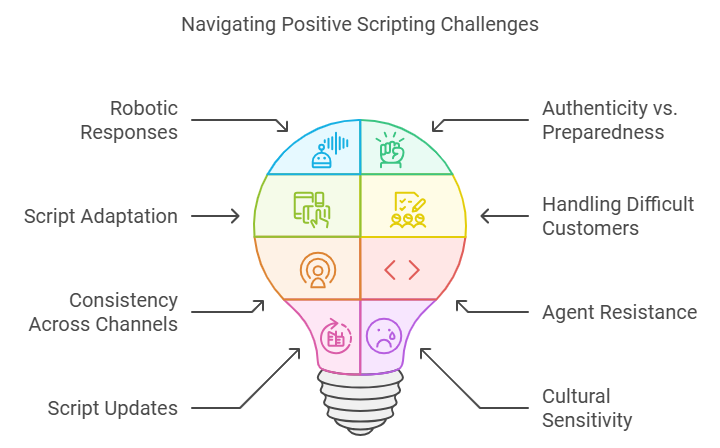When handling customer service interactions, every word matters. Positive scripting is about using positive language to guide conversations, enhance customer interaction, and limit frustration. But is it just about “sounding nice”? Not really. Whether you’re training new hires or optimizing current processes, well-crafted customer service scripts can make all the difference. It’s about creating an experience where your support agents address concerns while leaving a lasting positive impression. This guide will help you create effective customer service scripts that empower your team to handle any situation confidently and positively.
In this article, we’ll cover practical tips for implementing positive note, strategies to train your customer service teams, and real-world examples of how it can transform your customer interactions. Whether you’re a seasoned customer service professional or just starting out, this guide offers practical tips for positive scripting that will leave a lasting impression on your customers. Whether you’re managing a call center or training fresh team addition, this guide will help you design a customer service script that boost confidence, reinforce your brand’s core values, and encourage loyalty from both new and repeated customers.
Ready to learn how to empower your customer support reps and deliver better customer service? Let’s get started.
Understanding Positive Scripting
What is Positive Scripting?
Positive scripting in customer support refers to the use of well-crafted customer service script with pre-approved, constructive responses to guide customer interactions enhance the overall customer experience and reduce frustration. Positive scripting relies on using pre-approved customer service scripts that guide conversations toward solutions and leave a positive impression.
It’s designed to replace negative words or phrases with positive words, ensuring every customer interaction leaves a good impression. Positive scripting isn’t just about responses—it starts with a strong initial greeting. For example, instead of saying, “I can’t do that,” a customer service representative might say, “Here’s what I can do for you.”
Why Does It Matter?
Positive scripting helps build confidence in customer service agents and improves customer loyalty. It also limit customer frustration by focusing on solutions rather than problems. Using standardized customer service scripts, your team can deliver consistent, solution-oriented responses that build trust and satisfaction. When a frustrated customer feels heard and valued, the interaction becomes an opportunity to strengthen your Business ethics and create a consistent experience across your support channels.
Key Benefits of Positive Scripting:
- Encourages constructive interactions – Keeps the tone of conversations focused on solutions.
- Builds agent confidence – Support reps feel equipped to handle challenging scenarios.
- Improves customer satisfaction – Positive responses show empathy and care.
- Enhances brand loyalty – A positive tone reflects well on your company name and fosters repeat customer.
- Reduces customer frustration – Minimizes the chances of escalation by offering solutions upfront.
- Provides consistency – A customer service script ensures all Client service professionals deliver a uniform customer experience, whether on live chat support, phone, or email.
- Improves agent morale – Guides customer service agents with clear, prepared responses, reducing stress in difficult situations.
- Strengthens customer communication – Builds trust by focusing on what can be done rather than what can’t.
- Supports new team members – Helps onboard new hires with customer support scripts they can confidently follow.
- Facilitates faster resolutions – Positive phrases and solutions-oriented language lead to quicker issue handling.
Tips and Strategies for Effective Positive Scripting

Creating and using positive scripts isn’t just about writing polite sentences. It’s about empowering your consumer service agents to deliver meaningful, solution-focused responses. Here are actionable tips to make positive scripting effective for your customer service interactions:
1. Focus on Solutions, Not Problems
Instead of pointing out what can’t be done, highlight alternatives. This helps limit customer irritation and keeps the interaction productive. For example, Indiana age verification can help resolve age-related concerns by providing clear alternatives, ensuring compliance while maintaining a solution-oriented tone.
Example:
- Negative: “We don’t have that item in stock.”
- Positive: “That item is currently unavailable, but I can check if it’s in another location or suggest a similar product.”
2. Use Empathy to Address Customer Emotions
Positive scripting must acknowledge a customer’s frustration or concerns to build trust and improve the overall customer experience. Encourage customer support teams to show they understand the customer’s point of view.
Example:
- “I can see how this situation might be upsetting. Let me help you fix it.”
3. Keep Scripts Flexible and Natural
Rigid scripts can make your agents sound robotic. Train Customer success agents to adapt scripts to fit the situation while maintaining a positive tone. Role-playing exercises with customer support scripts can build confidence and ensure they’re prepared for live customer interactions.
4. Regularly Update Your Scripts
Customer issues evolve, so it’s important to review and revise scripts to address new customer queries and incorporate feedback from your team. Regularly revising your customer service scripts keeps them relevant and ensures they reflect current customer concern and expectations. Positive scripting in customer service is most effective when it’s dynamic and relevant.
5. Balance Scripting with Authenticity
While scripts are helpful, genuine communication is key to positive customer interactions. Guide Help desk staff to combine scripted responses with personal touches to ensure they connect with the customer directly.
6. Use Positive Words and Phrases
Teach your support team to replace negative words with positive words. A simple shift in language can change the tone of an entire interaction, leading to a more constructive and satisfying customer experience.
Examples of Positive Replacements:
- Negative: “I don’t know.” → Positive: “Let me find that information for you.”
- Negative: “You’ll have to wait.” → Positive: “I’ll ensure this is resolved as quickly as possible.”
7. Tailor Scripts for Different Channels
Customer service interactions happen across phone calls, live chat, and email. Customize scripts to fit the tone and limitations of each medium. Your customer service scripts should be customized for live chat, email, and phone support to align with the nuances of each medium. For such instances, live chat support requires concise yet engaging responses, while phone interactions benefit from empathy conveyed through tone.
8. Train Agents to Handle Angry Customers
Prepare your team with specific scripts for frustrated or angry customers. For example, include phrases like:
- “I understand your frustration, and I’m here to help.”
- “Let’s work together to get this resolved.”
9. Reinforce Positive Brand Voice
Ensure your scripts align with your company’s customer service values. A consistent brand voice builds trust and reassures potential customers that they’re in capable hands.
10. Encourage Team Feedback
Ask your Customer care associates to share feedback about the scripts they use. This helps identify what works and what doesn’t, improving the effectiveness of positive scripting over time.
Implementing Positive Scripting in Your Organization

Turning positive scripting into a reality requires thoughtful planning and execution. Follow these steps to integrate it seamlessly into your customer service operations:
1. Define the Goals for Positive Scripting
Start by identifying what you want to achieve. Common objectives include improving customer interaction, reducing frustration, and empowering your support team to handle complex scenarios. Align these goals with your Organizational values
2. Involve Your Customer Service Team
Engage your user service agents in the scripting process. They have firsthand knowledge of user concerns and can provide valuable insights into what phrases work during customer interactions. Collaborative input ensures scripts feel authentic and practical.
3. Develop Customized Customer Service Scripts
Create scripts tailored to your industry, typical customer issues, and common pain points. For example, a call center script for resolving billing issues will differ from one addressing product returns. Use positive language and phrases that reflect your company’s customer service standards.
4. Guide Customer Service Representatives
Provide training sessions to familiarize your team with positive scripting techniques that directly impact the customer experience by fostering empathy and effective communication. Focus on teaching them how to prepare positive responses, handle frustrated customers, and use scripts naturally without sounding rehearsed. Role-playing is an excellent way to practice.
5. Incorporate Scripts into Onboarding
Introduce agent confidence positive scripting to new staff during onboarding. This ensures they start with the tools and confidence needed to represent your company’s customer service effectively.
6. Monitor Customer Service Interactions
Use feedback from live chat, call center teams, and customer satisfaction surveys to evaluate the impact of positive scripting. Track metrics like customer loyalty, resolution time, and repeated customer behavior to measure its effectiveness. Use feedback from live chat, call center agents, and customer satisfaction surveys to evaluate whether positive scripting delivers the intended consistent experience.
7. Adapt Scripts Based on Feedback
No script is perfect from the start. Regularly review feedback from both your support rep and customers. Use this input to refine scripts, making them more effective in addressing evolving consumer concerns.
8. Empower Agents to Go Beyond Scripts
While scripts provide a framework, scripting in customer service rep. must be empowered to deviate when necessary. Encourage agents to use positive scripting as a guide, adapting it to meet the unique needs of each customers directly.
9. Leverage Technology
Use customer service tools to make scripts accessible and easy to update. For instance, a shared knowledge base can help valuable customer support team find the right responses quickly. AI tools in live chat support systems can also assist by suggesting positive phrases in real time.
10. Celebrate Successes
Recognize agents who excel at using positive scripting to create memorable customer experiences. This boosts morale and reinforces the importance of maintaining a positive tones in every interaction.
Challenges and Considerations for Positive Scripting

While positive scripting can transform customer interactions, it’s not without its challenges. Some team members may feel constrained by customer service scripts, but proper training can show them how these scripts are tools to guide conversations, not limit creativity. Let’s explore some common pitfalls and how to overcome them:
1. Sounding Robotic or Insincere
The Challenge: Over-reliance on scripts can make customer service agents sound mechanical, leading to customer dissatisfaction.
The Solution: Encourage agents to personalize responses while staying within the script’s framework. Training should focus on delivering scripted responses in a conversational tone.
2. Balancing Authenticity and Preparedness
The Challenge: Customers value authentic interactions. If scripting feels forced, it may reduce trust and loyalty.
The Solution: Train agents to adapt scripts to fit the customer’s emotions and the context of the conversation. Emphasize empathy and active listening.
3. Adapting Scripts for Different Scenarios
The Challenge: A single script won’t fit all customer service situations, leading to frustration when agents encounter unique issues.
The Solution: Develop a library of create customer service scripts for different scenarios. Equip agents with guidelines to combine scripts or create tailored responses on the spot.
4. Handling Angry or Frustrated Customers
The Challenge: Positive scripting can sometimes feel inadequate when dealing with angry customers.
The Solution: Provide agents with scripts specifically designed to de-escalate tense situations. Focus on empathy and actionable solutions, such as:
- “I understand why this has been frustrating. Let’s resolve this together.”
5. Ensuring Consistency Across Channels
The Challenge: Customers expect consistent experiences, but different channels (e.g., live chat, phone calls, and emails) may require varying tones or response styles.
The Solution: Customize scripts for each channel while maintaining consistent messaging. For instance, call center agents can focus on tone, while live chat support emphasizes brevity and clarity.
6. Resistance from Agents
The Challenge: Some Service advisors may feel scripts limit their creativity or autonomy.
The Solution: Position positive scripting as a tool, not a rulebook. Highlight how scripts provide support rather than constraints, enabling agents to focus on customer concerns.
7. Difficulty in Updating Scripts
The Challenge: Outdated scripts can lead to inconsistent or irrelevant responses.
The Solution: Establish a process for regularly reviewing and updating scripts based on customer feedback and emerging trends in client concerns.
8. Cultural and Linguistic Sensitivity
The Challenge: Scripts that work well in one region may not resonate with customers elsewhere.
The Solution: Localize scripts to ensure they respect cultural norms and use language familiar to the target audience.
By anticipating and addressing these challenges, you can ensure that positive scripting becomes an asset for your customer service teams rather than a limitation.
Case Studies and Examples of Successful Positive Scripting
Positive scripting can drive real results when applied thoughtfully. Here are examples and case studies that highlight its impact in different customer service scenarios:
Case Study 1: Reducing Customer Frustration at a Call Center
The Problem:
A large call center for a telecom company faced high levels of customer displeasure due to long wait times and frequent service outages. Agents often used negative language, which escalated customer dissatisfaction.
The Solution:
The company introduced positive scripting to focus on empathy and solutions. Scripts were customized to include phrases like:
- “I understand how this delay is inconvenient, and I’ll do everything I can to resolve this quickly.”
- “Here’s an alternative plan while we work on restoring your service.”
The Results:
- Customer satisfaction scores improved by 25%.
- Average call resolution time decreased by 15%.
- Agents reported increased confidence in handling difficult calls.
Case Study 2: Enhancing Live Chat Support in E-Commerce
The Problem:
An online retailer received complaints about impersonal responses in live chat support. Customers felt their concerns weren’t acknowledged properly.
The Solution:
The company implemented positive scripting tailored to the chat format. Responses were designed to balance empathy and efficiency. For example:
- “Thank you for bringing this to my attention! Let me find the best solution for you right away.”
- “I see how this can be frustrating. I’m here to make things right for you.”
The Results:
- 40% fewer escalations to phone support.
- Positive brand voice reinforced across customer interactions.
- Repeat users rate increased by 20%.
Example 1: Handling an Angry Customer in Retail
An in-store customer demanded a refund for a defective product. Using positive scripting, the service rep said:
- “I’m sorry this didn’t meet your expectations. Let me issue a refund right away and help you find a replacement product that works better for you.”
Outcome: The customer left satisfied and returned to the store for future purchases.
Example 2: Solving a Billing Issue in SaaS
A SaaS customer was confused about additional charges. The support agent used positive phrase like:
- “I can explain those charges for you. Let’s go over them together and ensure everything is correct.”
Outcome: The customer felt valued and renewed their subscription.
Example 3: Onboarding New Team Members in a Hospitality Chain
The company introduced scripts for handling common customer queries like room upgrades or service complaints. New support agents were trained to use positive language, such as:
- “I’d be happy to check if we have a room upgrade available for you.”
Outcome: New hires were confident and effective from day one.
FAQs
1. How do I make sure my agents don’t sound robotic?
Encourage agents to personalize their responses and adapt scripts to the context of the conversation. Role-playing exercises during training can help agents practice delivering scripts naturally.
2. Can positive scripting work for all types of businesses?
Yes, but it must be customized. For instance, call center scripts may require concise phrasing, while retail scripts can focus more on face-to-face empathy.
3. What if a customer insists on something that’s not possible?
Focus on what you can do. Use phrases like, “While that option isn’t available, here’s something I can offer that might help.”
4. How do I measure the effectiveness of positive scripting?
Track metrics such as customer satisfaction scores, resolution times, and repeat customers rates. Customer feedback is also a great indicator of success.
5. How often should I update scripts?
Review scripts at least quarterly or whenever there’s a significant change in customer concerns, business processes, or feedback from your team.
Conclusion: Why Positive Scripting is a Must-Have for Customer Service
Positive scripting isn’t just a buzzword; it’s a proven strategy to enhance every aspect of the customer experience, turning routine interactions into opportunities to build loyalty.. By replacing negative words with positive words, empowering agents with confidence, and crafting scripts tailored to real-world challenges, businesses can create customer experiences that inspire loyalty and trust.
Whether you’re managing call centers, live chat support, or in-person customer interactions, positive scripting helps to align your team’s communication with your Company principles. It reduces customer dissatisfaction, increases satisfaction, and gives your team the tools to handle even the most difficult conversations.
As you build and refine your positive scripts, remember: flexibility, empathy, and authenticity are key. Scripts are a guide, not a limitation, helping your team deliver better customer service across every interaction.


